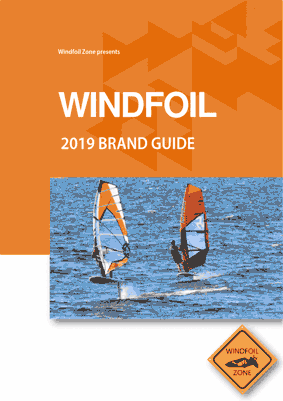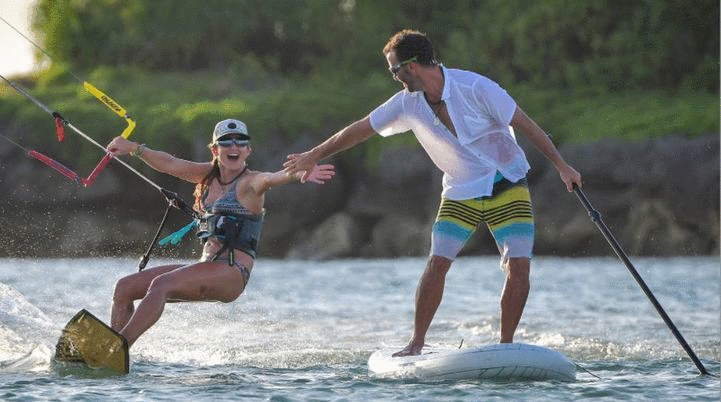Windfoiling vs wingfoiling? Windsurfers share their experience – Part 3: Tez Plavenieks
- Romain
- Aug 8, 2020
- 4 min read
Updated: Oct 31, 2020
Third chapter in our series of articles where windsurfers share their experience of winging. Today, we talked to Tez Plavenieks, founding editor of Windsurfing UK magazine.
Tez gives us a nuanced and realistic view on wingfoiling, explaining that learning the wing thing is not as straight forward as it looks like.
Read also our three other interviews with Benjamin Tillier, Simon Croft and Dean Peaple, and our previous article where Tez gives his best tip to flight in light wind.
What is easiest to learn? Windfoiling or wingfoiling ?
If you're a windsurfer who's thinking of getting involved with foiling then I'd suggest sticking with what you know first off. Winging isn't as straight forward as you'd imagine because of the two separate bits of gear that are independent of one another.
In contrast, because of the rig being attached to the board, windfoil setups are one complete unit. And the feeling will be familiar making it arguably easier to understand the foil and learn the ropes.
Wings meanwhile behave independently of the board and foil. It's much harder to try and learn how to control the wing and learn to foil. Most tend to go down the 'being towed behind a boat' route to get familiar with lifting before working on the wing itself. But not everyone will have access to a boat.
I understand the appeal of wings: lightweight, easier to set up (although that's not strictly true as I can rig a windsurf sail just as fast) and a wider freedom of movement once on the water. But it's all relative. Learning the ropes in windfoil mode first will stand you in good stead when/if you decide to opt into winging.

I think for windsurfers windfoiling is easier to learn as you already possess the foundational fundamental skills. Winging requires new muscle memory and a different approach.
There are a bunch of nuances that'll be unfamiliar. With windfoiling, any competent sailor will be able to jump onboard and foil from the off - as in lift and fly. There'll be plenty of crashing for sure. It's then a case of working on controlling/sustaining ride height.
It'll probably take a few sessions on the wing before you're lifting. Although I will add winging isn't super hard either. If you compare it to learning to plane, using harness and footstraps windsurfing, then it's much quicker/easier.

What about wing range, how light wind can you go?
I can windsurf foil in 6 knots of wind with the right foil wing and rig. There's no way I can do this (yet) with any wing set up. Of course, I've windfoiled much more but the problem with wings is their inefficiency compared with windsurf sails.
Because wings are inflatable they don't react to gusts as a sail will. Instead, they can warp, bend, and essentially have the wind blow straight through. Designs are getting better and some of the bigger sizes are much more powerful. The problem with some big wings is their additional weight, speed, and wing tips catching the water.

I've been lucky enough to provide R&D to some companies who are wanting to develop wings - particularly make them more user friendly and efficient for non-foiling SUP mode (I've done this a lot with SUP products in the past).
One brand (McConks) has given me a whole bunch of prototype wings in return for feedback (this is also makes for good magazine content). Over the course of 6-8 months, their wings have improved no end. This is just one example of a grassroots UK SUP brand making inroads to winging.
Bigger companies, like Slingshot, Duotone, Naish, and such, will be much quicker at prototyping and utilising new developments/materials and technologies. We're already seeing this with 2021 kit.

Do you think wingfoiling will get more popular and what is the future of windsurfing/windfoiling then?
It depends. There's still slow uptake across all foiling disciplines if we're being brutally honest, and gear isn't as readily available as you'd think - for various reasons not least COVID's impact on manufacturing and distribution.
Kite foiling is the most popular with surf foiling being second (globally). If you believe what you see on social media then you'd think every man and his dog is foiling, which isn't true. That said, if you take my home as a snapshot (Hayling Island, south coast, UK) then there are way more windsurf foilers than previous. This isn't surprising as Hayling's where windsurfing was invented and is the spiritual home of the sport in this country.
If you believe what you see on social media then you'd think every man and his dog is foiling, which isn't true.
In contrast wing foilers are still thin on the ground - around five or so regulars with a few visitors every now and then. Winging looks a little kooky and I think whilst people are intrigued they're not that keen to make the leap and purchase kit, which is still expensive. We did see a flurry of wing 'buys' in summer 2020 when 4m's were supposedly all you needed! It quickly became apparent that unless you weigh 60kg, live in Maui, and are a gifted ocean athlete this isn't true.

Personally, I'd like to see wings become more efficient. For instance, having elliptical leading edge bladders which are more aerodynamic would be good. Better low-end power and more reactive to pumping would be nice as well. Whilst keeping designs simple I think the nature of existing products sacrifices some elements.
And to be honest, even adding things like booms and battens doesn't really add much time to the rigging process. I'm also keen for better non-foiling wing products to be developed - especially with inflatable SUP boards in mind which are still massively popular. Not everyone wants to foil but there are some who still want to wing. If they keep disappearing off downwind, however, then they'll eventually get fed up and bin it.
Thanks for answering our questions Tez, foil on!
Tez Plavenieks
Editor, Windsurfing UK
Editor, SUP Mag UK
Action sports content creator - tezplavenieks.com














Comments